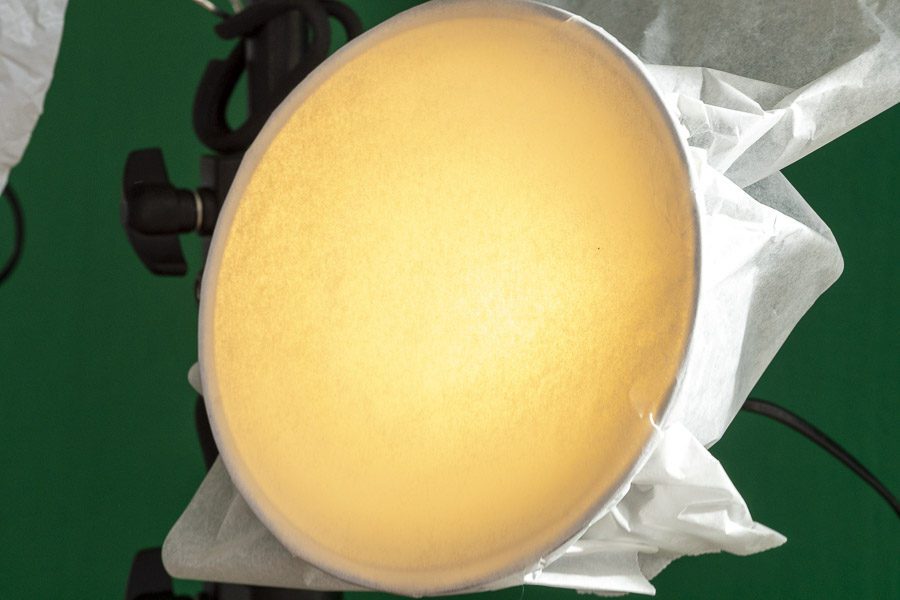DISCLOSURE: AS AN AMAZON ASSOCIATE I EARN FROM QUALIFYING PURCHASES. READ THE FULL DISCLOSURE FOR MORE INFO. ALL AFFILIATE LINKS ARE MARKED #ad
Harsh light has its uses. It heightens drama, creates sharp contrast, and works really well for tonally dark films and genres like action, sci-fi, thriller, and horror. But, say you’re not shooting a bleak apocalyptic thriller or grungy futuristic action film; say you want some soft lighting.
In that case, you’ll need to get your hands on some diffusion to throw in front of your lights. While generally not wildly expensive to buy, if you’re looking for a truly DIY option, there are plenty of cheap household items you’ve most likely got laying around that work to equally good effect.
Before we start: a note about heat and potential fire hazards.
Studio-level tungsten lights run hot. There’s no way around it. Keep this in mind when placing your diffusion. Some of the below-mentioned DIY options are not heat resistant and will need to be placed at a safe distance from your light to avoid catching on fire or melting.
A good solution to this problem is to use LED lights if you have any available. LED doesn’t generate much heat, so the distance of the diffusion to the light itself is of little consequence. LED color temperature may not match that of tungsten, so adjust your camera accordingly as well.
With that out of the way, here are five DIY light diffusers that you probably already own:
Parchment Paper

I’ve heard wax paper is the generally recommended DIY option, but, in my opinion, wax paper is too transparent and also is not heat resistant. While wax paper may work for lights that don’t generate heat, they’re not universally usable, so why use it at all when there’s a better option?
Enter parchment paper. More opaque, it works better for diffusing light and is completely heat-resistant. It won’t melt or burn up all over your lights. Just clamp it onto the barn doors of your unit or, if you’ve got a bigger piece, slap it onto a c-stand and position it at will.
This should get you solid diffusion for no trouble at all.
Frosted Shower Curtain
Like parchment paper, but on a much larger scale, a frosted shower curtain should prove opaque enough and sizeable enough for diffusion on all but the biggest lights. Like the opaque parchment paper, make sure you get frosted and not clear.
The only downside to using this is that it is not heat-resistant like parchment paper, so be wary of attaching it directly to the barn doors of your light, as it may melt down and stick to them. Instead, consider clamping the curtain to two c-stands and placing it a few feet from the light.
In this way, you can also control the level of diffusion desired by moving the curtain farther or closer to the light without fear of burning.
Go with something with a high gauge number (>8) (the thickness of the curtain) and no chemicals, e.g. like this one from DeLaine on Amazon for maximum diffusion.
White Garbage Bag

Although less ideal than the first two options, a white garbage bag can work decently well. The diffusion level will be higher over a shower curtain or parchment paper because a trash bag is less transparent. As long as you keep that in mind, you should be fine.
If necessary, you can also cut the bag into squares large enough to cover your light and then layer them to achieve the desired level of diffusion. Be aware that this will also cut the amount of light shining through the diffusion as well.
Like a shower curtain, garbage bags are flammable and susceptible to melting, so keep them on a c-stand and away from direct contact with your light!
White T-Shirt
Now if by some wild chance you couldn’t dig up the first three options around the house, this one is guaranteed to be lying around your house somewhere. A white t-shirt is not going to be as transparent as what’s mentioned above, but the light will still pass through it.
Experiment with the shirt folded over or flat to see which level of diffusion works for the shot you want.
Again, be aware of the flammability of the material. While t-shirts are unlikely to melt, they can burn. Cotton is a safer bet with a higher heat resistance threshold than synthetics like polyester.
As a side note, you can also try different colored t-shirts to adjust the color of your light, mimicking gels as well as diffusion. Darker colors will achieve better results, and you can possibly kill two birds with one stone using this method.
Printer Paper

Have you ever traced an image placed underneath a piece of printer paper? You can see enough to follow the lines, thus proving it transparent enough to serve as diffusion in a pinch. So, crack open that 500-page ream and take… well, just one page.
This one is definitely flammable though (duh), so keep it away from any non-LED lights and place it on its own stand.
Another thing to be conscious of with printer paper: The reflectivity of the whiteness will cut the light coming through slightly as well, so you may have to adjust the intensity of the light on your subject to keep the same exposure while still diffusing to your liking.
Never Be Without Diffusion Again
When professional diffusion is scarce or there’s just no budget for it, remember these five items for a solid DIY setup that will yield comparative results.
As a backup, I’d even recommend keeping a roll of parchment paper or a folded shower curtain in your gear bag because you never know when the need for it will arise. If not, it’s highly likely that any set you’re on will have at least one of the three other items available.
Conclusion
To recap: You can cut and shape these items as needed. You can attach them to the barn doors of your light as long as they are heat resistant or you’re running LEDs. Always be conscious of the heat of your tungsten lights and the flammability of your diffusion.
Indie filmmaking is all about creatively getting the job done without the budget to buy your way out of a situation. It’s no less so here.
Know of any other items that pull double duty as diffusion? Let us know in the comments below!


